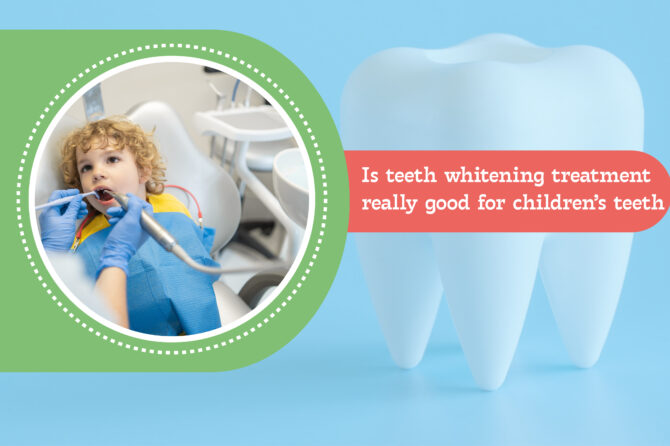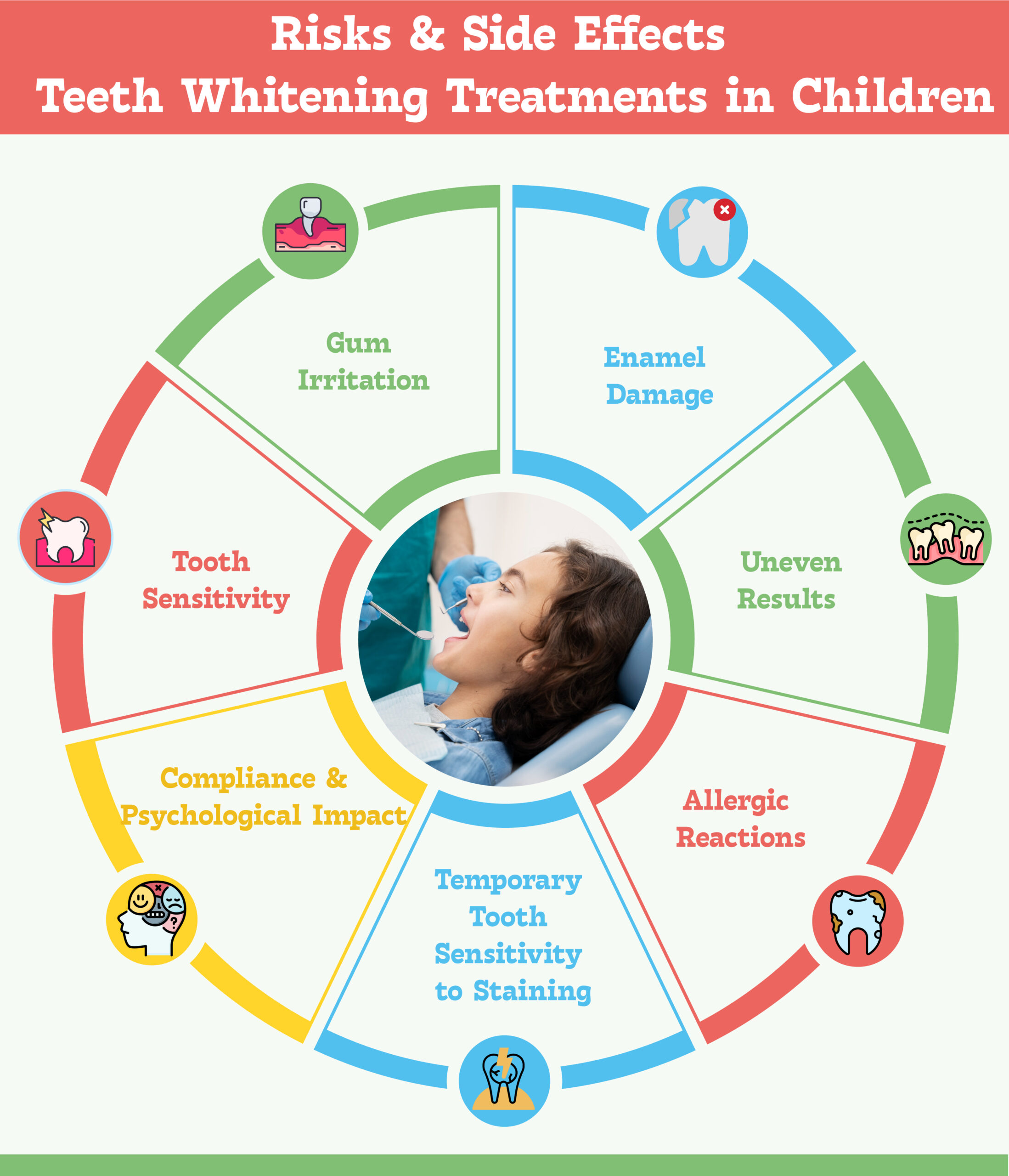
Is Teeth Whitening Treatment Really Good for Children’s Teeth?
In the realm of dental aesthetics, where smiles shine bright, there arises a question of concern – teeth whitening for children. As young teeth blossom the threat of tooth discoloration and treatments for youthful teeth whitening gains attention. However, amidst the excitement, it is important to proceed with caution. Scientific knowledge reminds us of potential risks and side effects, such as tooth sensitivity and gum irritation. Considering the developmental stage of teeth, age appropriateness and professional guidance become essential. An oral health evaluation uncovers any underlying issues like cavities, enamel defects, or gum disease. The expertise of pediatric dentists guides us toward safe whitening options. Within this realm, methods such as in-office bleaching, custom-fitted trays, and over-the-counter products like whitening toothpaste and strips are available, each with its own considerations. Yet, it is crucial not to overlook the significance of at-home care and maintenance, including oral hygiene practices, mindful dietary choices, and regular dental check-ups, which contribute to sustaining a transformed smile. Remember, teeth whitening is an option, but alternatives exist, grounded in good oral hygiene practices, professional cleanings, and making conscious decisions about foods and beverages that may cause stains. The foremost principle to uphold throughout this discussion is the safety and well-being of children’s teeth, guided by scientific knowledge and the pursuit of a healthy, vibrant smile.
How developmental stages of teeth impact the safety and effectiveness of teeth whitening procedures?
Children’s dental development encompasses a unique journey marked by the eruption sequence of both primary (baby) and permanent teeth. Understanding these distinctive characteristics is essential when considering teeth whitening for children and its impact on safety and effectiveness. The eruption sequence begins with the appearance of primary incisors, followed by canines, molars, and eventually the eruption of permanent teeth. This sequence, often accompanied by tooth discoloration due to factors like diet and oral hygiene, poses challenges to the timing and appropriateness of teeth whitening treatments. The safety of whitening procedures depends on the maturity of the enamel and dentin layers, which undergo continuous development throughout childhood. Premature whitening may interfere with this natural process, potentially compromising tooth structure and sensitivity. As such, adhering to recommended age ranges for teeth whitening is crucial. Additionally, understanding the eruption sequence aids in identifying which teeth are permanent or primary, ensuring that treatments target appropriate teeth. Lastly, providing teeth whitening tips tailored to children’s dental development, such as emphasizing proper oral hygiene, reducing consumption of staining foods and beverages, and regular dental check-ups, contributes to maintaining a healthy and radiant smile in a safe and effective manner.
Age Appropriateness: A Critical Factor in Ensuring the Safety of Teeth Whitening in Children
Teeth whitening treatments can be enticing for children seeking a brighter smile. However, age appropriateness is a critical factor in determining the safety and suitability of such procedures. Understanding the recommended age range and the reasons why younger children may not be suitable candidates is essential for responsible decision-making.
1. Developmental Considerations:
- Eruption Sequence: Children’s dental development follows a specific sequence, with primary (baby) teeth erupting before permanent teeth.
- Tooth Discoloration: Factors like diet and oral hygiene practices can contribute to tooth discoloration in both primary and permanent teeth.
2. Maturity of Tooth Structures:
- Enamel and Dentin Development: The enamel and dentin layers of teeth undergo continuous maturation during childhood.
- Safety Concerns: Premature teeth whitening treatments may interfere with this natural development, potentially compromising tooth structure and causing sensitivity.
3. Recommended Age Range:
- Professional Guidelines: Dental professionals typically recommend delaying teeth whitening until adolescence or until most or all of the permanent teeth have erupted.
- General Age Range: The recommended age range for considering teeth whitening treatments in children is typically 14-18 years.
4. Reasons Younger Children May Not Be Suitable Candidates:
- Immature Tooth Structures: Younger children may have less developed enamel and dentin layers, making them more susceptible to potential harm from whitening agents.
- Sensitivity and Irritation: Younger children may experience increased sensitivity and gum irritation due to their more delicate oral tissues.
- Compliance and Understanding: Younger children may have difficulty understanding and following the necessary instructions and precautions associated with teeth whitening treatments.
To ensure the safety and effectiveness of teeth whitening procedures in children, it is crucial to adhere to age-appropriate guidelines. By waiting until the recommended age range, when the tooth structures are more mature, the risk of adverse effects can be minimized. Dental professionals can provide valuable guidance in assessing a child’s suitability for teeth whitening treatments and suggesting alternative strategies to maintain a healthy and radiant smile.
Potential Risks and Side Effects of Teeth Whitening Treatments in Children:
1 Tooth Sensitivity:
- Teeth whitening treatments, especially those involving bleaching agents, can increase tooth sensitivity in children.
- The bleaching agents used in whitening procedures may penetrate the enamel and reach the dentin, causing temporary sensitivity to hot and cold stimuli.
2 Gum Irritation:
- Some children may experience gum irritation or inflammation as a result of teeth whitening treatments.
- The whitening agents can come into contact with the gingival tissues, leading to temporary discomfort or soreness.
3 Enamel Damage:
- Improper application or excessive use of teeth whitening products may lead to enamel damage in children.
- The abrasive nature of certain whitening agents can wear down the enamel, potentially weakening the tooth structure and increasing the risk of tooth decay.
4 Uneven Results:
- Teeth whitening treatments may result in uneven whitening or inconsistent coloration, particularly if the child has tooth discoloration with different underlying causes.
- The natural variations in enamel thickness, surface texture, and the response of different teeth to whitening agents can contribute to uneven results.
5 Allergic Reactions:
- Although rare, some children may experience allergic reactions to the components of teeth whitening products.
- Allergic symptoms may include itching, redness, swelling, or hives in the oral cavity or surrounding areas.
6 Temporary Tooth Sensitivity to Staining:
- Following teeth whitening treatments, children’s teeth may become temporarily more susceptible to staining.
- It is advised to avoid consuming highly pigmented foods and beverages, such as coffee, tea, berries, and colored sodas, immediately after whitening procedures to minimize potential discoloration.
7 Compliance and Psychological Impact:
- Teeth whitening treatments may require multiple sessions and consistent adherence to instructions.
- Younger children may find it challenging to comply with the treatment regimen, leading to suboptimal results or potential dissatisfaction.
It is important to consider these potential risks and side effects when contemplating teeth whitening treatments for children. Consulting with a dental professional is crucial to assess the child’s oral health, determine the appropriateness of whitening procedures, and provide guidance on minimizing risks and achieving desired outcomes.
Conclusion
Tooth discoloration is a concern, but risks and side effects must be acknowledged. Sensitivity, gum irritation, and enamel damage may arise. However, dental professionals offer guidance for safe treatments. Age appropriateness and tailored care pave the way to a radiant smile. Discover the expertise of Kids Dental Studio, where teeth whitening meets oral health with compassion.
Leave a reply

Leave a reply